-
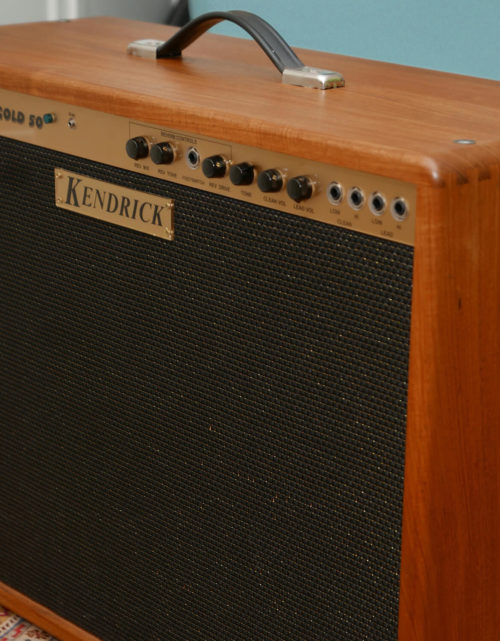 This was one of the best amps ever made by the legendary Gerald Weber. All-tube circuitry, designed and made in the USA, by Weber. It not only has power to spare (50 watts), but its unique circuitry has two channels, clean and lead, with different preamp circuit. These channels can be blended through patching the second input of one channel into the first input of the other, for purposes of blending the two channels together and further tone shaping with the interactive tone circuit. The bottom line: Tons of power if you need it, but the ability to get all the creamy, lush lead tones with the lead channel and/or blending. You just have to hear it. Original, handmade hardwood cabinet. 2 x 12: one 12 inch Kendrick brown frame and one 12 inch Kendrick black frame speaker. Kendrick's double spring reverb with three controls. Great condition. Recently serviced by one of the best amp techs in Texas. Price: $1495. No shipping. Local pickup only in Austin.
This was one of the best amps ever made by the legendary Gerald Weber. All-tube circuitry, designed and made in the USA, by Weber. It not only has power to spare (50 watts), but its unique circuitry has two channels, clean and lead, with different preamp circuit. These channels can be blended through patching the second input of one channel into the first input of the other, for purposes of blending the two channels together and further tone shaping with the interactive tone circuit. The bottom line: Tons of power if you need it, but the ability to get all the creamy, lush lead tones with the lead channel and/or blending. You just have to hear it. Original, handmade hardwood cabinet. 2 x 12: one 12 inch Kendrick brown frame and one 12 inch Kendrick black frame speaker. Kendrick's double spring reverb with three controls. Great condition. Recently serviced by one of the best amp techs in Texas. Price: $1495. No shipping. Local pickup only in Austin. -
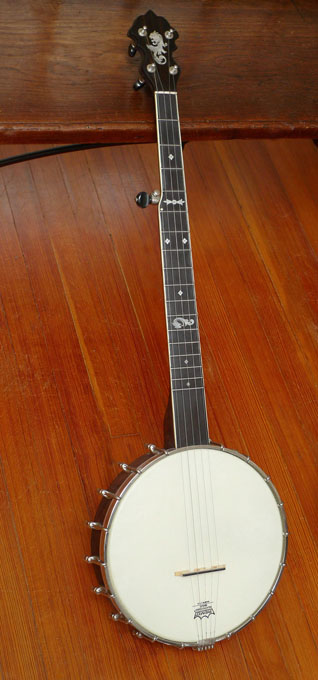 This is a one-of-a-kind custom banjo, from one of the country’s most respected luthiers, based in Appomattox, Virginia. I love this banjo for picking on the couch– it won’t put your back out, picking it up and putting it down, or crush your cat or your sweetheart. It’s lightweight, and with a custom-size head. But it packs beautiful full tone, not the tinny nasal sound from most open back banjos. It’s five or so years old, but with very little wear.
This is a one-of-a-kind custom banjo, from one of the country’s most respected luthiers, based in Appomattox, Virginia. I love this banjo for picking on the couch– it won’t put your back out, picking it up and putting it down, or crush your cat or your sweetheart. It’s lightweight, and with a custom-size head. But it packs beautiful full tone, not the tinny nasal sound from most open back banjos. It’s five or so years old, but with very little wear.- Dark stained maple rim, and neck
- 11 inch pot
- Ebony fretboard
- Engraved dragon inlay in peghead
- Custom MOP inlays
- Bound neck
- No Knot tail piece (Pat. Nov. 19 1901)
- 18 lug
- Brass hoop tone ring
- Dowell stick construction
- nut width 1-¼ inch
- scale: 25- ½ inches
- maple rim diameter: 10- ½ outside
- maple rim thickness: 7/16 inches
- Dark stained maple rim, and neck
- 11 inch pot
- Ebony fretboard
- Engraved dragon inlay in peghead
- Custom MOP inlays
- Bound neck
- No Knot tail piece (Pat. Nov. 19 1901)
- 18 lug
- Brass hoop tone ring
- Dowell stick construction
- nut width 1-¼ inch
- scale: 25-½ inches
- maple rim diameter: 10- ½ outside
- maple rim thickness: 7/16 inches
- With original case.
-
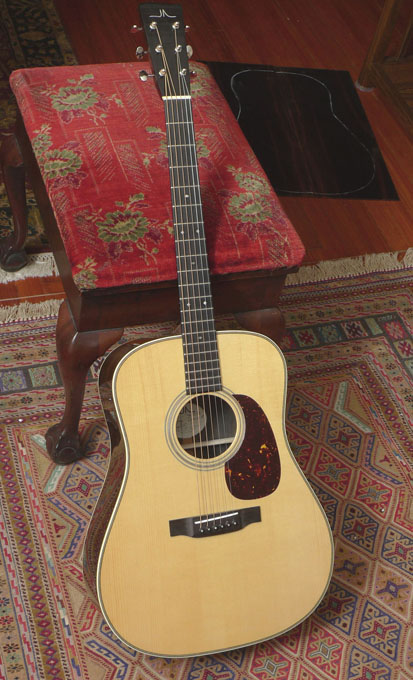 This is a new Allison Brazilian Rosewood dreadnought. Austin-based John Allison was a key part of the Collings Guitar team for years. John is now one of the most sought-after independent makers of fine instruments in the southwest. His guitars are carried by a number of top dealers in the U.S… and we’ve just snagged this brand new, wonderful Brazilian– a custom order guitar. Allison’s attention to detail is astounding. You just have to see and play this great brazilian. Right off the bench, it’s loud and beguiling, and it will only get better over time.
This is a new Allison Brazilian Rosewood dreadnought. Austin-based John Allison was a key part of the Collings Guitar team for years. John is now one of the most sought-after independent makers of fine instruments in the southwest. His guitars are carried by a number of top dealers in the U.S… and we’ve just snagged this brand new, wonderful Brazilian– a custom order guitar. Allison’s attention to detail is astounding. You just have to see and play this great brazilian. Right off the bench, it’s loud and beguiling, and it will only get better over time.- Top: Adirondack Spruce
- Back, and Sides: Brazilian Rosewood
- Bracing: Scalloped X, Adirondack
- Neck: Mahogany
- Finish: Nitrocellulose lacquer
- Herringbone purfling
- Ivoroid binding
- Fretboard: Ebony
- Bridge: Ebony
- Peghead veneer: Ebony
- Scale Length: 25.5 inches
- Nut Width: 1 11/16 inches
- Tuners: Waverly
-
 The Larson Brothers of Chicago never marketed any guitar, throughout their long career, that was marked “Larson”. Their designs were branded by Maurer, Stahl, Prarie State, Stetson, and a few other guitar makers– but never “Larson”. They were also known for making many “off-catalog” guitars, i.e. guitars with combinations of features that varied from the Maurer, Stahl, etc, catalogs, and guitars that were not marked at all with a brand. This guitar is a Larson Bros creation that is not marked at all. It is a custom made instrument–but it has all the typical Larson hallmarks. The tone of this Larson is every bit as wonderful as the Maurer/Larson listed above, indeed it is quite similar, due to the same patented “built under tension” design, and X-bracing. This Larson does not have laminated braces (it’s well documented that laminated braces were only used on certain models–and their use was not related to level or price.) Every part of this guitar is original, including original finish. There are two repaired cracks on the back, and three small, repaired cracks on top.
The Larson Brothers of Chicago never marketed any guitar, throughout their long career, that was marked “Larson”. Their designs were branded by Maurer, Stahl, Prarie State, Stetson, and a few other guitar makers– but never “Larson”. They were also known for making many “off-catalog” guitars, i.e. guitars with combinations of features that varied from the Maurer, Stahl, etc, catalogs, and guitars that were not marked at all with a brand. This guitar is a Larson Bros creation that is not marked at all. It is a custom made instrument–but it has all the typical Larson hallmarks. The tone of this Larson is every bit as wonderful as the Maurer/Larson listed above, indeed it is quite similar, due to the same patented “built under tension” design, and X-bracing. This Larson does not have laminated braces (it’s well documented that laminated braces were only used on certain models–and their use was not related to level or price.) Every part of this guitar is original, including original finish. There are two repaired cracks on the back, and three small, repaired cracks on top.- Lower bout width: 12 5/8 inches
- Brazilian rosewood back and sides
- Ivory celluloid Bound fretboard
- Ivory celluloid Bound headstock
- Spruce top
- X braced
- Larson’s patented “built under tension” design
- Rosette: Abalone pearl and wood inlay bordering the sound hole
- Radiused ebony fingerboard, and Classic Larson Brothers’ “ebony below the binding”
- Engraved inlays on fretboard
- Original tuners
- Original ebony bridge
- Original bridge pins
- 1-7/8" wide nut
- 2 1/4" bridge string spacing
- 24.3" scale length
- One-piece mahogany neck, round C shaped neck profile.
-
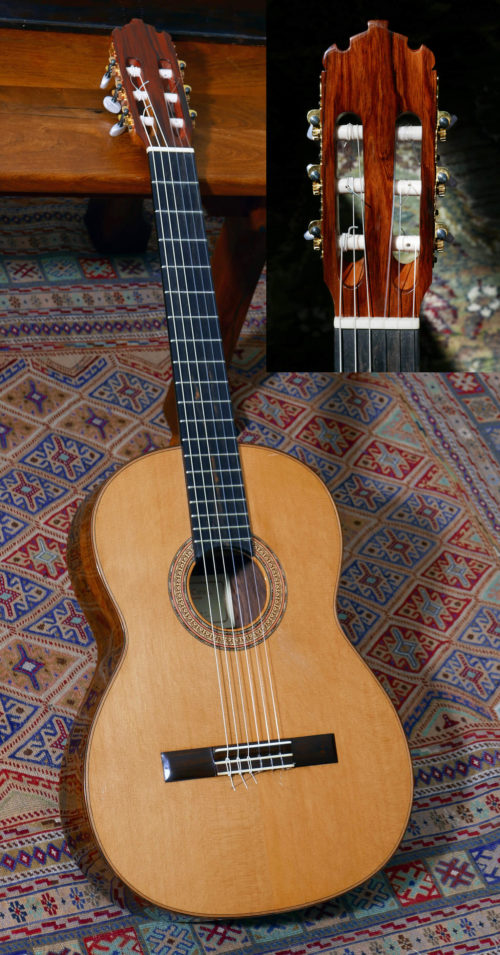 Acquired from the original owner – who bought this wonderful instrument directly from David Caro in the mountain town of the maker, one of the best luthiers that Paracho, Mexico has ever produced – in the mid 90’s and hand-carried it to California where it was lightly played. And it remains in remarkable original condition. The maker is David Caro, also known as David Caro Leonardo, or David Caro L. (In Mexico, the last/last name, in this case “Leonardo”, is the mother’s maiden name that is formally added after a person’s last [paternal] name but typically dropped in all but formal situations, documents etc.) Caro’s best instruments are among the best of a small, elite group that honed their craft at the top levels, and also benefited from visits and master classes given in Paracho by some world class luthiers from Spain, Germany, and the USA such as Felix Manzanero, Antonio Raya Pardo, Jose Romanillos, Thomas Humphery, and Herman Hauser III. Only a few Paracho luthiers have stood out over the years – Jose Navarro, Arturo Huipe, Abel Garcia, Enos Hernandez (his best work), German Vasquez Rubio, and Caro among them. See the enclosed photos from Fretboard Journal magazine, Spring 2008, that featured David Caro prominently in the feature article in that issue on Paracho luthiers. Paracho is an originally Tarascan village that sits in a high valley at 7,300 feet altitude, in the state of Michoacán, a relatively little visited state but renowned for its diversity and great beauty – and for some of the best classical guitar luthiers in the Americas. It extends from the Pacific coast, and is crossed by the Sierra Madre Del Sur in its southern part and by high volcanic mountains in its northern axis. When this guitar was made, in 1996, David Caro was at the height of his craft. And soon after, he was the first luthier to be added to the GSA calendar. This instrument is among the very best guitars ever made by Caro. And we love the model designation, it’s signed by hand on the label, “Mdo. 500”, i.e. “model 500” – sounds like a sports car name. Model 500 was the top model from Caro, in 1995/96 – using top woods, and also the best bindings, and all details. In those years, Caro’s best concert instruments went from model 100 at the base level, then ascending in tone woods and overall construction details to 200, 300, 400, then reaching the top level of “500”. So we’re calling this instrument, “el Quinientos”. (Spanish for “the 500” – nice ring to that – it’s pronounced “key-knee-éntose”) Several things make this guitar stand out as a gem: • It’s the top model from this luthier in the 1990’s • The great original condition • Scale length of 648mm. This scale length is reminiscent of Herman Hauser I’s guitars, and is firmly in the school of the shorter 650 range, not the longer scale lengths that crept in, in the last quarter of the 20th century. This is a great scale length – and note the nut width is a typical nut width of a full size classical guitar. And the neck thickness is great – on the thinner side. This combination makes it a joy to play and so easy to play – but the tone is superb. The full tone, and volume are better than most longer scale guitars. • Light weight/construction, that really allows it to sing. Its total weight, with strings, is a remarkably lithe 1430 grams • And it has great combination of woods: • Palo Escrito back and sides, bridge, and headplate veneer. DALBERGIA PALOESCRITO, is a true rosewood, a great wood that over the years came to be favored by the top luthiers in Paracho – for their top models. It sounds like Brazilian rosewood, but a tad different, and it’s not as “dark” in tone as Indian rosewood. Palo Escrito is lighter in weight and density than either brazilian or Indian rosewood. And weight, is of course part of the equation of a guitar that does translate to tone. Palo Escrito makes this guitar really breathe, and resonate. The lighter weight of this guitar is its charm, that translates to tone – slightly more airy and open, less “closed”, and with full round basses. The tone is clear, with superb string separation, as from the best spruce over rosewood guitars. Surprising volume – but it perhaps produces the best tone, in more delicate playing where you want each note to stand out – that’s of course called good “string separation”: the notes in a run or chord don’t all “blend together” but each note is discernable. And we think it’s accurate to say that this guitar, with its light weight and 648 scale length and combination of woods, has a tone that leans to a great Flamenco negra tone. Fast attack on the trebles, with a touch of growl in the bass when you play them hard. Yet the guitar responds very well to a light touch as well. If you’re looking for another ho-hum, non-descript spruce over Indian rosewood classical tone, this instrument is not for you. • Spruce top – European Alpine spruce • Ebony fingerboard • Ebony reinforcing strips, back of neck • Ebony heel cap • Beautiful rosette, with a hearts & rope pattern (another homage to Bernabe). • Palo Escrito is also used in the binding, back center strip, tie block, and purfling • The headstock shape is an homage to Paulino Bernabe. • Fan strutting, with 5 braces. The braces are very thin, and also scalloped – contributing to the great tone of the instrument. The scale length of the guitar, if it's not on the longer side, allows the luthier to be use more delicate bracing, adding to tone. (Longer scale length guitars produce more tension on the top due to the higher string tension inherent in a longer scale, so luthiers typically have to brace more strongly with longer scale lengths.) • And there is unique, 2-rosewood cleat application under the bridge – one cleat added by Caro at time of construction, on either end of the bridge, on the underside of top, for stability of the top wood beneath the bridge ends. It's worked well. • Good saddle height– and the neck is very straight, and there will never be any neck bowing issues or issue with too high action. Condition: 100% crack-free All original, thin lacquer finish Frets, and fretboard show very little wear A few nicks and dings, and a small amount of fingernail marks in the “pick guard” area. Overall, the condition is what you’d expect from an instrument that’s been played, carefully, for maybe a year, not 20+ years. But the tone is aged, open, clear – benefiting from more than two decades of aging and drying of the woods. Scale length: 648mm Nut Width: 52mm (2 2/32 inches) String spacing at nut: 45mm (1 ¾ inches) Width at lower bout: 14 ¼ inches Body depth, at bottom: 4 inches Body depth, at neck/body joint: 3 ¾ inches Weight (fully strung): 1430 grams (3.15 pounds) In a modern, hard shell case. Price: $4,750.
Acquired from the original owner – who bought this wonderful instrument directly from David Caro in the mountain town of the maker, one of the best luthiers that Paracho, Mexico has ever produced – in the mid 90’s and hand-carried it to California where it was lightly played. And it remains in remarkable original condition. The maker is David Caro, also known as David Caro Leonardo, or David Caro L. (In Mexico, the last/last name, in this case “Leonardo”, is the mother’s maiden name that is formally added after a person’s last [paternal] name but typically dropped in all but formal situations, documents etc.) Caro’s best instruments are among the best of a small, elite group that honed their craft at the top levels, and also benefited from visits and master classes given in Paracho by some world class luthiers from Spain, Germany, and the USA such as Felix Manzanero, Antonio Raya Pardo, Jose Romanillos, Thomas Humphery, and Herman Hauser III. Only a few Paracho luthiers have stood out over the years – Jose Navarro, Arturo Huipe, Abel Garcia, Enos Hernandez (his best work), German Vasquez Rubio, and Caro among them. See the enclosed photos from Fretboard Journal magazine, Spring 2008, that featured David Caro prominently in the feature article in that issue on Paracho luthiers. Paracho is an originally Tarascan village that sits in a high valley at 7,300 feet altitude, in the state of Michoacán, a relatively little visited state but renowned for its diversity and great beauty – and for some of the best classical guitar luthiers in the Americas. It extends from the Pacific coast, and is crossed by the Sierra Madre Del Sur in its southern part and by high volcanic mountains in its northern axis. When this guitar was made, in 1996, David Caro was at the height of his craft. And soon after, he was the first luthier to be added to the GSA calendar. This instrument is among the very best guitars ever made by Caro. And we love the model designation, it’s signed by hand on the label, “Mdo. 500”, i.e. “model 500” – sounds like a sports car name. Model 500 was the top model from Caro, in 1995/96 – using top woods, and also the best bindings, and all details. In those years, Caro’s best concert instruments went from model 100 at the base level, then ascending in tone woods and overall construction details to 200, 300, 400, then reaching the top level of “500”. So we’re calling this instrument, “el Quinientos”. (Spanish for “the 500” – nice ring to that – it’s pronounced “key-knee-éntose”) Several things make this guitar stand out as a gem: • It’s the top model from this luthier in the 1990’s • The great original condition • Scale length of 648mm. This scale length is reminiscent of Herman Hauser I’s guitars, and is firmly in the school of the shorter 650 range, not the longer scale lengths that crept in, in the last quarter of the 20th century. This is a great scale length – and note the nut width is a typical nut width of a full size classical guitar. And the neck thickness is great – on the thinner side. This combination makes it a joy to play and so easy to play – but the tone is superb. The full tone, and volume are better than most longer scale guitars. • Light weight/construction, that really allows it to sing. Its total weight, with strings, is a remarkably lithe 1430 grams • And it has great combination of woods: • Palo Escrito back and sides, bridge, and headplate veneer. DALBERGIA PALOESCRITO, is a true rosewood, a great wood that over the years came to be favored by the top luthiers in Paracho – for their top models. It sounds like Brazilian rosewood, but a tad different, and it’s not as “dark” in tone as Indian rosewood. Palo Escrito is lighter in weight and density than either brazilian or Indian rosewood. And weight, is of course part of the equation of a guitar that does translate to tone. Palo Escrito makes this guitar really breathe, and resonate. The lighter weight of this guitar is its charm, that translates to tone – slightly more airy and open, less “closed”, and with full round basses. The tone is clear, with superb string separation, as from the best spruce over rosewood guitars. Surprising volume – but it perhaps produces the best tone, in more delicate playing where you want each note to stand out – that’s of course called good “string separation”: the notes in a run or chord don’t all “blend together” but each note is discernable. And we think it’s accurate to say that this guitar, with its light weight and 648 scale length and combination of woods, has a tone that leans to a great Flamenco negra tone. Fast attack on the trebles, with a touch of growl in the bass when you play them hard. Yet the guitar responds very well to a light touch as well. If you’re looking for another ho-hum, non-descript spruce over Indian rosewood classical tone, this instrument is not for you. • Spruce top – European Alpine spruce • Ebony fingerboard • Ebony reinforcing strips, back of neck • Ebony heel cap • Beautiful rosette, with a hearts & rope pattern (another homage to Bernabe). • Palo Escrito is also used in the binding, back center strip, tie block, and purfling • The headstock shape is an homage to Paulino Bernabe. • Fan strutting, with 5 braces. The braces are very thin, and also scalloped – contributing to the great tone of the instrument. The scale length of the guitar, if it's not on the longer side, allows the luthier to be use more delicate bracing, adding to tone. (Longer scale length guitars produce more tension on the top due to the higher string tension inherent in a longer scale, so luthiers typically have to brace more strongly with longer scale lengths.) • And there is unique, 2-rosewood cleat application under the bridge – one cleat added by Caro at time of construction, on either end of the bridge, on the underside of top, for stability of the top wood beneath the bridge ends. It's worked well. • Good saddle height– and the neck is very straight, and there will never be any neck bowing issues or issue with too high action. Condition: 100% crack-free All original, thin lacquer finish Frets, and fretboard show very little wear A few nicks and dings, and a small amount of fingernail marks in the “pick guard” area. Overall, the condition is what you’d expect from an instrument that’s been played, carefully, for maybe a year, not 20+ years. But the tone is aged, open, clear – benefiting from more than two decades of aging and drying of the woods. Scale length: 648mm Nut Width: 52mm (2 2/32 inches) String spacing at nut: 45mm (1 ¾ inches) Width at lower bout: 14 ¼ inches Body depth, at bottom: 4 inches Body depth, at neck/body joint: 3 ¾ inches Weight (fully strung): 1430 grams (3.15 pounds) In a modern, hard shell case. Price: $4,750. -
Out of stock
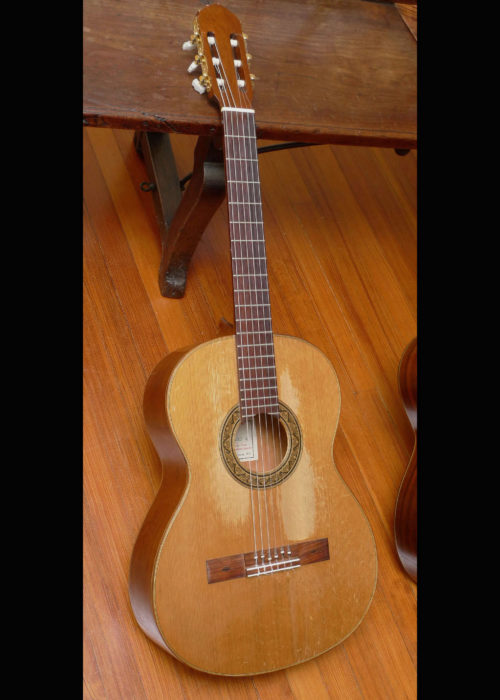
- Cedar top
- Depth at lower bout: 4 3/16 inches
- Width of neck at nut: 2 inches
- Body length: 19 3/4
-
 When this concert guitar was made in 1976, it was the top model offered by the master luthier Masaru Kohno– when he was at the very height of his career. There is some confusion out there as to which Kohno was the “top” concert model at any given date in height of Masaru Kohno’s career– from the early 70’s to the late-80s’. No confusion here– as there is correspondence (from August 2011) directly from Masaki Sakurai to us, regarding this guitar. Masaki Sakurai (nephew of Masaru Kohno, who in fact worked along side Masaru Kohno when this instrument was made in 1976, and now of course runs the “Sakurai/Kohno” shop, since the death of Masaru Kohno in 1998) confirms that this guitar was the top model available from Kohno in mid-1976. (Don’t be confused– a later, for example 1980 No. 30 Kohno is not a top Kohno model from that year. By 1980, the top model was a No. 50.) The confusion arises because Kohno had, in the early 70s until the late 80’s the custom of making his model numbers correspond to the guitars’ price in Japanese Yen. Hence, this guitar, a “No. 30”, in mid-1976, was priced at 300,000 Japanese Yen, and was the top model (a very expensive guitar in 1976). The confusion arises because as the inflation-prone 70’s continued, everyone adjusted prices upward. When inflation kept advancing, Kohno model numbers were something of a moving target, and the “top model” number changed upwards over time. Over time the top model moved up to No. 30 (this guitar), and then later No. 50 (starting in 1977). Kohno finally stopped using numbers in the 80’s and then called the top model the “Professional J”, and on, with more variations of “Professional”.) In any case this guitar, was the top model made, when it came from the Kohno shop (correspondence from Masaki Sakurai confirming this, will be supplied). But the real proof is in the playing. This instrument stands along with the best brazilian rosewood/spruce concert guitars from any maker, anywhere, any period. Crystal clear brazilian trebles. Wonderful resonance, combined with superior string separation.
When this concert guitar was made in 1976, it was the top model offered by the master luthier Masaru Kohno– when he was at the very height of his career. There is some confusion out there as to which Kohno was the “top” concert model at any given date in height of Masaru Kohno’s career– from the early 70’s to the late-80s’. No confusion here– as there is correspondence (from August 2011) directly from Masaki Sakurai to us, regarding this guitar. Masaki Sakurai (nephew of Masaru Kohno, who in fact worked along side Masaru Kohno when this instrument was made in 1976, and now of course runs the “Sakurai/Kohno” shop, since the death of Masaru Kohno in 1998) confirms that this guitar was the top model available from Kohno in mid-1976. (Don’t be confused– a later, for example 1980 No. 30 Kohno is not a top Kohno model from that year. By 1980, the top model was a No. 50.) The confusion arises because Kohno had, in the early 70s until the late 80’s the custom of making his model numbers correspond to the guitars’ price in Japanese Yen. Hence, this guitar, a “No. 30”, in mid-1976, was priced at 300,000 Japanese Yen, and was the top model (a very expensive guitar in 1976). The confusion arises because as the inflation-prone 70’s continued, everyone adjusted prices upward. When inflation kept advancing, Kohno model numbers were something of a moving target, and the “top model” number changed upwards over time. Over time the top model moved up to No. 30 (this guitar), and then later No. 50 (starting in 1977). Kohno finally stopped using numbers in the 80’s and then called the top model the “Professional J”, and on, with more variations of “Professional”.) In any case this guitar, was the top model made, when it came from the Kohno shop (correspondence from Masaki Sakurai confirming this, will be supplied). But the real proof is in the playing. This instrument stands along with the best brazilian rosewood/spruce concert guitars from any maker, anywhere, any period. Crystal clear brazilian trebles. Wonderful resonance, combined with superior string separation.- Hand-signed on label by Masaru Kohno, and dated 1976
- Solid European spruce top
- Solid Brazilian rosewood back and sides
- 660mm scale length
- Nut: 52mm
- Mahogany neck with 2 ebony supporting strips
- Ebony fretboard
- Gold engraved Gotoh tuners
- One repaired crack on back of guitar
- Crack-free top and sides. There are various nicks, dings, and scratches.
- Finish is naturally worn off, through playing, on the center section of the back of the neck– giving it a very fast feel in the left hand.
-
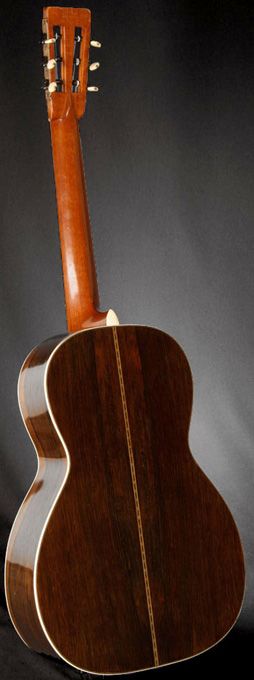 Signed by Martin factory foreman, underside of top: “6/1886”, this 0-28 is in stunning original condition. 1886 is the last year of the original factory in Nazareth, before Martin built the new factory addition in 1887. It is also the last year before they installed mechanized steam-run equipment to bend sides. So this wonderful 0-28, is one of the last of the totally hand-crafted Martins, built without mechanized equipment, and signed as such, 1886. Instrument is 100% original: finish, bridge, ivory nut, ivory saddle, ivory pins, bar frets, everything.
Signed by Martin factory foreman, underside of top: “6/1886”, this 0-28 is in stunning original condition. 1886 is the last year of the original factory in Nazareth, before Martin built the new factory addition in 1887. It is also the last year before they installed mechanized steam-run equipment to bend sides. So this wonderful 0-28, is one of the last of the totally hand-crafted Martins, built without mechanized equipment, and signed as such, 1886. Instrument is 100% original: finish, bridge, ivory nut, ivory saddle, ivory pins, bar frets, everything.- Crack-free
- repaired center seam on top
- Shows very little wear
- Scalloped braces (X-braced)
- original maple bridge plate
- original French-polish shellac finish throughout
- 13.5" wide at lower bout, and 4.25" deep at the endpin
- 24.9" scale length
- 1-7/8" wide nut
- soft-V neck profile.
-
Out of stock
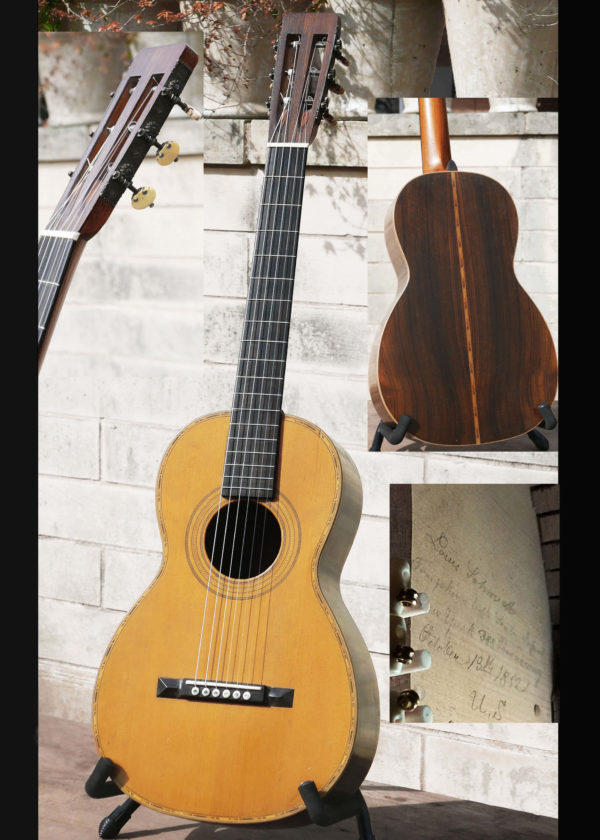 It’s beyond rare to find a guitar from the early Martin – Coupa - Schmidt – Maul – Schatz era in this state of preservation. And one this large. This rare model Schmidt & Maul guitar – by the original C.F. Martin's most famous colleagues and contemporaries– is signed and dated, October 18th, 1852, and is in its original coffin case. And best of all– it plays wonderfully, with low action. A unique piece of American guitar history– not for hanging on the wall but to play. The instrument is signed on the underside of the top: Louis Schmidt Tompkinsville Staten Island New York 388 Broadway October 18th 1852 U.S. This higher end, Spanish neck/heel (not ice-cream cone) Schmidt & Maul is bigger than all the Schmidt & Maul, Schmidt, or George Maul guitars that have come up for sale in the past decades (and not many of any kind have come up for sale). It’s a bit larger than a size 2 Martin, with a width at lower bout of 12 3/16 inches.(Every other Schmidt & Maul that has come to market has been a smaller guitar.) The guitar is braced inside (all original) with an early X-bracing variation similar to the 1953 Schmidt & Maul featured on p. 213 of the book “Inventing the American Guitar– The Pre-Civil War Innovations of C.F. Martin and His Contemporaries” edited by Robert Shaw and Peter Szego. (Hal Leonard Books, 2013). Like the 1853 guitar illustrated in that book, this guitar has bracing on top and back that is very close to the guitar that CF Martin and Schatz made for Madame de Goni. With all original finish, original ebony bridge, and original Jerome tuners– it’s in remarkable condition. To get the best of both worlds– historically authenticity and playability– the guitar has just had a recent neck set, original bridge reglue, and other minor work including new saddle, by one of the country’s top luthiers and authorities for early Martin and early American guitars– Steve Kovacik. All work was done by Steve to historically correct preservation standards after extensive examination and consultation. (Note, in the photo: the picture of the signature inside the guitar: the two cleats are not later repairs– rather they are two center seam-stabilizing cleats put in by the original luthiers in 1852.) Amazingly, this guitar plays in tune up and down the fretboard. Thank the original luthiers at 388 Broadway for that– they had the foresight to add slight compensation (not angled saddle compensation but cheating the saddle back a bit) to the bridge/saddle. Not even CF Martin did that in those years). And thanks to Steve Kovacik for setting this instrument up with low action not ballpark “19th century” action. The Adirondack top is crack-free. Crack-free sides. There are two almost imperceptible cracks on the back– you have to look hard to see them, both addressed by Steve Kovacik.
It’s beyond rare to find a guitar from the early Martin – Coupa - Schmidt – Maul – Schatz era in this state of preservation. And one this large. This rare model Schmidt & Maul guitar – by the original C.F. Martin's most famous colleagues and contemporaries– is signed and dated, October 18th, 1852, and is in its original coffin case. And best of all– it plays wonderfully, with low action. A unique piece of American guitar history– not for hanging on the wall but to play. The instrument is signed on the underside of the top: Louis Schmidt Tompkinsville Staten Island New York 388 Broadway October 18th 1852 U.S. This higher end, Spanish neck/heel (not ice-cream cone) Schmidt & Maul is bigger than all the Schmidt & Maul, Schmidt, or George Maul guitars that have come up for sale in the past decades (and not many of any kind have come up for sale). It’s a bit larger than a size 2 Martin, with a width at lower bout of 12 3/16 inches.(Every other Schmidt & Maul that has come to market has been a smaller guitar.) The guitar is braced inside (all original) with an early X-bracing variation similar to the 1953 Schmidt & Maul featured on p. 213 of the book “Inventing the American Guitar– The Pre-Civil War Innovations of C.F. Martin and His Contemporaries” edited by Robert Shaw and Peter Szego. (Hal Leonard Books, 2013). Like the 1853 guitar illustrated in that book, this guitar has bracing on top and back that is very close to the guitar that CF Martin and Schatz made for Madame de Goni. With all original finish, original ebony bridge, and original Jerome tuners– it’s in remarkable condition. To get the best of both worlds– historically authenticity and playability– the guitar has just had a recent neck set, original bridge reglue, and other minor work including new saddle, by one of the country’s top luthiers and authorities for early Martin and early American guitars– Steve Kovacik. All work was done by Steve to historically correct preservation standards after extensive examination and consultation. (Note, in the photo: the picture of the signature inside the guitar: the two cleats are not later repairs– rather they are two center seam-stabilizing cleats put in by the original luthiers in 1852.) Amazingly, this guitar plays in tune up and down the fretboard. Thank the original luthiers at 388 Broadway for that– they had the foresight to add slight compensation (not angled saddle compensation but cheating the saddle back a bit) to the bridge/saddle. Not even CF Martin did that in those years). And thanks to Steve Kovacik for setting this instrument up with low action not ballpark “19th century” action. The Adirondack top is crack-free. Crack-free sides. There are two almost imperceptible cracks on the back– you have to look hard to see them, both addressed by Steve Kovacik.- “Schmidt & Maul New York” stamps on neck block, and center strip inside guitar
- X-braced, all original braces inside
- Spanish foot construction
- Radiused Ebony fretboard
- All historically correct bar fret replacement by Steve Kovacik (not too high, and not too thick– correct size bar frets were used, properly finished)
- Original bridge plate, in fine condition
- Original Jerome tuners and buttons
- Original nut, and saddle, in case. New nut and saddle by Steve Kovacik
- Rosette: shares a feature with early Martins– a variant of the "tooth" rosette– a three ring rosette with green "tooth" inner ring, and small "rope" outer rings
- Marquetry Purfling around top, + Maple binding
- Back purfling (backstrip): see Martin Guitars: A Technical Reference, p. 13: this is a “Pre-1867 style 34” Martin style purfling
- Maple binding, back
- Solid Adirondack top
- Solid brazilian rosewood back and sides
- Cedar, Spanish style neck and heel
- Width at lower bout: 12 3/16 inches
- Body length: 18 ¼ inches
- Nut width: 1 15/16 inches
- String spacing at bridge: 2 5/16
- Scale length: 24 ½ inches (But there is a slight compensation: 12th fret to the saddle– Schmidt and Maul added a touch of compensation !
- Original scooped-back ebony bridge
- 100% original finish. No overspray, touch-up, etc. anywhere…wonderful finish
-
Out of stock
 The Larson Brothers of Chicago never marketed any guitar, throughout their long career, that was marked “Larson”. Their designs were branded by Maurer, Stahl, Prairie State, Stetson, and a few other guitar makers– but never “Larson”. They were also known for making many “off-catalog” guitars, i.e. guitars with combinations of features that varied from the Maurer, Stahl, etc, catalogs, and guitars that were not marked at all with a brand. This guitar is a Larson Bros creation that is not marked at all. It is a custom made instrument–but it has all the typical Larson hallmarks. The tone of this Larson is every bit as wonderful as the Maurer/Larson listed above, indeed it is quite similar, due to the same patented “built under tension” design, and X-bracing. This Larson does not have laminated braces (it’s well documented that laminated braces were only used on certain models–and their use was not related to level or price.) Every part of this guitar is original, including original finish. There are two repaired cracks on the back, and three small, repaired cracks on top.
The Larson Brothers of Chicago never marketed any guitar, throughout their long career, that was marked “Larson”. Their designs were branded by Maurer, Stahl, Prairie State, Stetson, and a few other guitar makers– but never “Larson”. They were also known for making many “off-catalog” guitars, i.e. guitars with combinations of features that varied from the Maurer, Stahl, etc, catalogs, and guitars that were not marked at all with a brand. This guitar is a Larson Bros creation that is not marked at all. It is a custom made instrument–but it has all the typical Larson hallmarks. The tone of this Larson is every bit as wonderful as the Maurer/Larson listed above, indeed it is quite similar, due to the same patented “built under tension” design, and X-bracing. This Larson does not have laminated braces (it’s well documented that laminated braces were only used on certain models–and their use was not related to level or price.) Every part of this guitar is original, including original finish. There are two repaired cracks on the back, and three small, repaired cracks on top.- Lower bout width: 12 5/8 inches
- Brazilian rosewood back and sides
- Ivory celluloid Bound fretboard
- Ivory celluloid Bound headstock
- Spruce top
- X braced
- Larson’s patented “built under tension” design
- Rosette: Abalone pearl and wood inlay bordering the sound hole
- Radiused ebony fingerboard, and Classic Larson Brothers’ “ebony below the binding”
- Engraved inlays on fretboard
- Original tuners
- Original ebony bridge
- Original bridge pins
- 1-7/8" wide nut
- 2 1/4" bridge string spacing
- 24.3" scale length
- One-piece mahogany neck, round C shaped neck profile.
-
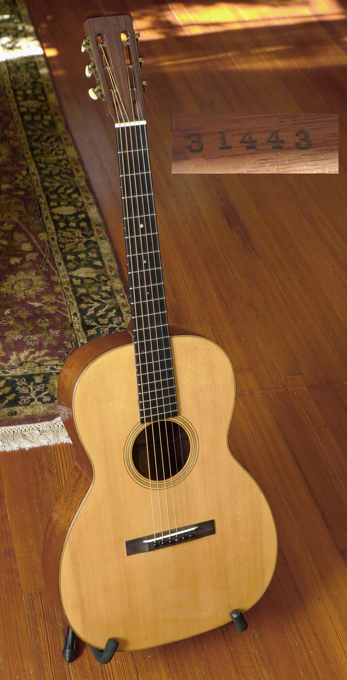 Long-scale, 000 sized 12-fret Martins from the late 20’s are among the most sought-after prewar instruments. This was the biggest, loudest Martin made for steel strings in this era, with a 25.4 inch scale length, the same scale length as a 30’s D-45. (The 14-fret 000’s of the 30s and later have a shorter, 24.5 inch scale). In no other instrument will you get the resonance (from thin tops and back), combined with the long scale length. It’s a big pre-war Martin 12-fret. That’s why this instrument is one of the most highly sought-after prewar Martins– and increasingly very difficult to find. But it’s all about one thing: the tone, emanating from a large-bodied 12-fret that plays wonderfully, and loud, even with the most delicate fingerpicking. The bass response here is the best you will ever find in any prewar Martin 12-fret guitar. This wonderful 000-18 was set up restored and set up by none other than Gruhn Guitars in Nashville– to impeccable standards. Gruhn refinished the top, back and sides. Neck, fretboard, headstock, are all original finish. Gruhn also replaced the bridge with a perfectly correct ebony bridge. The guitar has its original bridgeplate. New, period-correct Bar frets were installed by Gruhn. 1 7/8” nut. Mahogany back and sides. Adirondack spruce top. Ebony fingerboard. It has original tuners (gear wheel below worm gear, ivoroid buttons). The top and back of the guitar are completely crack-free and perfect– with full thickness the same as the day they left the factory. And the totally crack-free top shows absolutely perfect form and shape, with no undue bellying behind the bridge. There are a couple of almost imperceptible side cracks that were addressed by Gruhn, almost impossible to see from the outside. One of the most sought-after prewar Martin 12-frets, restored correctly, and set up, by the world’s best. (Included: a signed, in-hand Appraisal of the guitar– by George Gruhn)
Long-scale, 000 sized 12-fret Martins from the late 20’s are among the most sought-after prewar instruments. This was the biggest, loudest Martin made for steel strings in this era, with a 25.4 inch scale length, the same scale length as a 30’s D-45. (The 14-fret 000’s of the 30s and later have a shorter, 24.5 inch scale). In no other instrument will you get the resonance (from thin tops and back), combined with the long scale length. It’s a big pre-war Martin 12-fret. That’s why this instrument is one of the most highly sought-after prewar Martins– and increasingly very difficult to find. But it’s all about one thing: the tone, emanating from a large-bodied 12-fret that plays wonderfully, and loud, even with the most delicate fingerpicking. The bass response here is the best you will ever find in any prewar Martin 12-fret guitar. This wonderful 000-18 was set up restored and set up by none other than Gruhn Guitars in Nashville– to impeccable standards. Gruhn refinished the top, back and sides. Neck, fretboard, headstock, are all original finish. Gruhn also replaced the bridge with a perfectly correct ebony bridge. The guitar has its original bridgeplate. New, period-correct Bar frets were installed by Gruhn. 1 7/8” nut. Mahogany back and sides. Adirondack spruce top. Ebony fingerboard. It has original tuners (gear wheel below worm gear, ivoroid buttons). The top and back of the guitar are completely crack-free and perfect– with full thickness the same as the day they left the factory. And the totally crack-free top shows absolutely perfect form and shape, with no undue bellying behind the bridge. There are a couple of almost imperceptible side cracks that were addressed by Gruhn, almost impossible to see from the outside. One of the most sought-after prewar Martin 12-frets, restored correctly, and set up, by the world’s best. (Included: a signed, in-hand Appraisal of the guitar– by George Gruhn) -
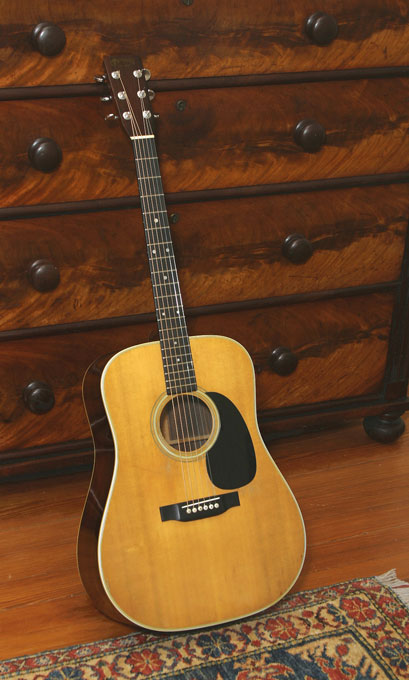 The last of the Mohicans, made within a few months before Martin stopped using Brazilian Rosewood on its instruments. Some guitars feel dead right the minute you pick them up. This is on of those. First and foremost, the tone of this instrument is unsurpassed for the bell-like trebles that only come from Brazilian Rosewood. The tone of this guitar, I would hold up to most mid-40’s D-28’s I’ve played. Playability, and set-up: it could not be better, and it’s got that 60’s combination of low action, great tuning speed and accuracy from the Grovers, and superb intonation all the way to the wee frets. More than anything, this guitar stands out for its low action combined with robust tone. Amazingly, the string height at the 12th fret: Just a hair over 2/32” at the high E; and 3/32 at the low E. It plays in our left hand like a dream, fast and fluid… yet the tone is full with no buzzing anywhere. I personally have never played a Martin dreadnought from any period that is so effortless to play, so easy on the left hand and so fast and yet so full of Brazilian tone. BTW, light gauge strings only? No way… I’ve got it strung with medium gauge, and it plays like butter in your left hand. Condition:
The last of the Mohicans, made within a few months before Martin stopped using Brazilian Rosewood on its instruments. Some guitars feel dead right the minute you pick them up. This is on of those. First and foremost, the tone of this instrument is unsurpassed for the bell-like trebles that only come from Brazilian Rosewood. The tone of this guitar, I would hold up to most mid-40’s D-28’s I’ve played. Playability, and set-up: it could not be better, and it’s got that 60’s combination of low action, great tuning speed and accuracy from the Grovers, and superb intonation all the way to the wee frets. More than anything, this guitar stands out for its low action combined with robust tone. Amazingly, the string height at the 12th fret: Just a hair over 2/32” at the high E; and 3/32 at the low E. It plays in our left hand like a dream, fast and fluid… yet the tone is full with no buzzing anywhere. I personally have never played a Martin dreadnought from any period that is so effortless to play, so easy on the left hand and so fast and yet so full of Brazilian tone. BTW, light gauge strings only? No way… I’ve got it strung with medium gauge, and it plays like butter in your left hand. Condition:- all original: finish; frets bridge, bridge plate, saddle. (Bridge pins could be replacements, hard to tell, but they are right.)
- The bridge looks like it has never been off
- Neck has never been set
- There is minor pickwear, with some moderate wear around the soundhole.
- No cracks on top; two, almost indiscernible cracks on back, that have been addressed–glued (no cleats). You have to look very hard to see these two back cracks, they are hairline cracks, each about 6 inches long.. but they are not visible from more than a few inches away, and impossible to photograph.
- Minor nicks and dings, most are visible in photos
- No strap lugs ever added
- Original end pin
- Throw away the book on this one… This is one of the best Brazilian rosewood Dreadnought Martins you’ll play, period, in fine original condition.